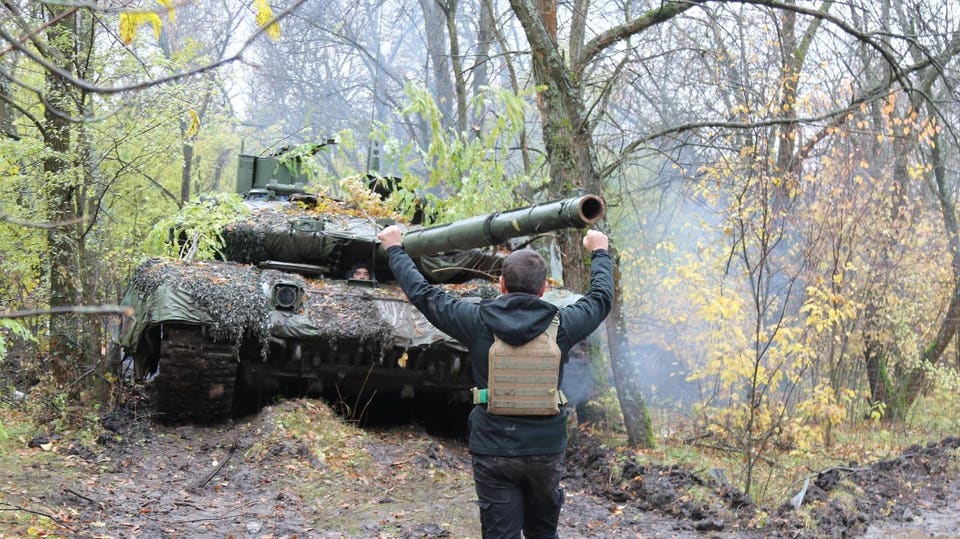David Axe Forbes Staff I write about ships, planes, tanks, drones, missiles and satellites. Following Oct 6, 2023, 05:33pm EDT | Share to Facebook Share to Twitter Share to Linkedin An ex-Russian T-90M in Ukrainian service. Wikimedia Commons Russian forces in Ukraine are losing more and more of their best T-90M tanks.
Believe it or not, that’s not entirely good news for Ukraine, nor bad news for Russia. That’s because the spike in T-90 write-offs seems to be related to the growing number of T-90s on the front line, 21 months into Russia’s wider war on Ukraine. The Russians are losing more T-90s because they have more T-90s to lose.
If it’s really happening—and it’s not 100-percent certain it is—the surge in T-90 deployments would underscore the bizarre disposition of the Russian armored corps as its wartime losses exceed 2,100 tanks. That’s two-thirds of the tanks the Russians went to war with in February 2022. The Russians have lost so many tanks that they’ve had no choice but to reactivate and rush to the front hundreds of 50-, 60- and even 70-year-old T-72 Ural, T-62 and T-54/55 tanks, often with no major upgrades to their optics, fire-controls or armor.
But the aged tanks are expedients: temporary stopgaps as Russian industry mobilizes and adapts to tightening foreign sanctions on the imported high-end electronics the industry once depended on. The Kremlin for nearly two years has been trying to boost tank production. And the effort finally is paying off.
Russian-made optics are replacing sanctioned optics from France. And where before just one factory—the Uralvagonzavod plant in Sverdlovsk Oblast—built tanks from scratch (T-72B3Ms and T-90Ms); now Omsktransmash in Siberia also is retooling for tracks-up production of T-80BVMs. How many new and upgraded tanks the plants can produce is, for outsiders, a matter of speculation.
In April, CNN estimated Uralvagonzavod alone delivered around 20 tanks a month. But a few weeks earlier, Defense Express reported that Uralvagonzavod, Omsktransmash and various upgrade workshops together could deliver 90 tanks a month. If Defense Express ’s number is accurate, then Russian industry is very close to completing enough new and upgraded tanks every month to keep up with losses.
And while the upgraded tanks—including the oldest T-62s and T-54/55s—are a finite resource, relying as they do on existing chassis and turrets, there’s a good reason to believe reactivated mid-Cold-War tanks are accounting for a shrinking proportion of overall Russian tank deliveries since peaking in late 2022. That evidence is losses. Broadly speaking, an army should lose tanks roughly in proportion to how many of a particular tank model it deploys.
While the specific capabilities of a tank type might make it more or less survivable relative to other types, those differences really only matter on the margins. Look closely. Russian losses of old T-62s peaked in October 2022.
Losses of upgraded T-80s peaked in June this year. And now T-90 losses are peaking: the Russians in total have written off around 60 of the 53-ton, three-person tanks, with most of the losses occurring in just the last few months. The destroyed and captured T-90s account for roughly 15 percent of all T-90s the Russians had in their inventory before the wider war.
But that doesn’t take into account new production. Uralvagonzavod since early 2022 has had time to produce several hundred new T-90s. And as those new T-90s arrive on the front line, oftentimes with airborne units or other elite formations that may have spent much of 2023 as operational reserves, they afford the Ukrainians more opportunities to knock out or capture T-90s.
Yes, it’s being generous to the Russians to characterize a spike in T-90 losses as good news for the Kremlin’s genocidal war effort. But it’s hard to characterize the gradual, but successful, mobilization of the Russian tank industry as anything but an ominous development for Ukraine. The Ukrainians would be better off if the only replacement tanks the Russians could deploy were 70-year-old T-54Bs.
What’s most ominous is that, nearly two years into the wider war, Ukraine’s main tank tank plant—the Malyshev Factory in Kharkiv—still isn’t producing new tanks from scratch. Yes, the factory reactivates, upgrades and repairs ex-Soviet T-64s, T-72s and T-80s. But it hasn’t produced a totally new tank in three decades —and shows no sign of mobilizing the way Uralvagonzavod and Omsktransmash have mobilized.
That leaves the Ukrainian tank corps at the mercy of Kyiv’s foreign allies. The only new, or new-ish, tanks the Ukrainians can count on receiving are those its allies deign to release from their own inventories, or divert from active production lines. So far, foreign donations have been paltry—at least when it comes to Western-style tanks such as German Leopard 2s, British Challenger 2s and American M-1s.
Ukraine is getting just 85 Leopard 2s, 14 Challenger 2s and 31 M-1s. In just six months, Uralvagonzavod could manufacture enough new T-90Ms to match Ukraine’s entire inventory of modern Western tanks. Follow me on Twitter .
Check out my website or some of my other work here . Send me a secure tip . David Axe Editorial Standards Print Reprints & Permissions.
From: forbescrypto
URL: https://www.forbes.com/sites/davidaxe/2023/10/06/russia-is-losing-more-of-its-best-t-90-tanks-perhaps-because-it-has-more-t-90s-to-lose/



